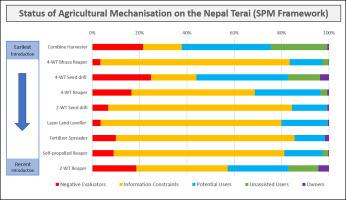Agricultural Systems ( IF 6.1 ) Pub Date : 2021-06-15 , DOI: 10.1016/j.agsy.2021.103200 Brendan Brown 1 , Gokul P Paudel 1 , Timothy J Krupnik 2

|
CONTEXT
The desire for agricultural mechanisation is mainstreaming across the Global South, yet there are limited tools through which to monitor and estimate progress made in pursuit of this. Despite Nepal enacting an agricultural development agenda focused on mechanisation to address issues of productivity, labour scarcity, inclusive economic growth and sustainability, it remains one of the few places in South Asia that is yet to see substantial agricultural mechanisation rates. We use this scenario as a case study to propose and investigate adoption processes.
OBJECTIVE
This research aims to provide a baseline to understand progress made towards Agri-mechanisation on the Nepal Terai. Despite decades of promotional efforts, there are only limited comprehensive analyses of the status of agricultural mechanisation in Nepal that cover diverse machinery and go beyond binary adoption estimates, nor a framework to understand different types of (non-)adopters.
METHODS
The applied non-binary ‘Stepwise Process of Mechanisation’ framework provides a systematic process for investigation of the status of agricultural mechanisation on the Nepal Terai. This framework is applied to representative survey data from 14 districts across 1569 households from Nepal's Plains (Terai) region.
RESULTS AND CONCLUSIONS
Results suggest that decades of activity have not yet led to the substantial closure of exposure gaps, nor sufficient ownership of machines that enables accessible fee-for-hire service provision. Exposure gaps were substantial in all machines, meaning current demonstration programs may not be achieving their targeted outcomes. Across nearly all machinery, a primary reason for limited progression to sustained adoption was a lack of service providers, a manifestation of limited machinery ownership, meaning current broad subsidy programs aimed at procurement may not be achieving intended outcomes. However, substantial pools of potential adopters and concentration of supply-side constraints highlight that with targeted intervention, rapid rural mechanisation is possible in the near future on the Nepal Terai.
SIGNIFICANCE
This research provides a foundation on which to understand the progress made towards small holder agricultural mechanisation. For the first time in South Asia, a systematic analysis through a novel stepwise framework has clarified and updated the status of agricultural mechanisation on the Nepal Terai. This work also lays the foundation for future work to explore the drivers, implications and inclusiveness of agri-mechanisation, utilising the identified typologies, both in Nepal and more broadly where increased nuance in understanding the status of agricultural mechanisation is warranted.
中文翻译:

通过逐步框架可视化采用过程:尼泊尔特莱机械化案例研究
语境
对农业机械化的渴望正在全球南方主流化,但用于监测和估计在实现这一目标方面取得的进展的工具有限。尽管尼泊尔制定了以机械化为重点的农业发展议程,以解决生产力、劳动力稀缺、包容性经济增长和可持续性等问题,但它仍然是南亚为数不多的农业机械化率尚未显着提高的地区之一。我们使用此场景作为案例研究来提出和调查采用流程。
客观的
这项研究旨在提供一个基线,以了解在尼泊尔特莱的农业机械化方面取得的进展。尽管进行了数十年的推广工作,但对尼泊尔农业机械化状况的全面分析非常有限,其中涵盖了多种机械且超出了二元采用率估计,也没有一个框架来了解不同类型的(非)采用者。
方法
应用的非二元“机械化逐步过程”框架为调查尼泊尔特莱的农业机械化状况提供了一个系统的过程。该框架适用于来自尼泊尔平原(Terai)地区 1569 个家庭的 14 个地区的代表性调查数据。
结果和结论
结果表明,数十年的活动尚未导致暴露差距的实质性缩小,也没有导致能够提供可访问的按租费服务提供的机器的足够所有权。所有机器的曝光差距都很大,这意味着当前的演示计划可能无法实现其目标结果。在几乎所有机械中,持续采用进展有限的主要原因是缺乏服务提供商,这是机械所有权有限的表现,这意味着目前针对采购的广泛补贴计划可能无法实现预期结果。然而,大量的潜在采用者和集中的供应方限制突出表明,通过有针对性的干预,尼泊尔特莱在不久的将来可以实现快速的农村机械化。
意义
这项研究为了解小农农业机械化取得的进展奠定了基础。在南亚,首次通过新的逐步框架进行系统分析,澄清和更新了尼泊尔特莱的农业机械化状况。这项工作还为未来探索农业机械化的驱动因素、影响和包容性奠定了基础,利用已确定的类型,无论是在尼泊尔还是更广泛的地方,都需要对农业机械化状况的理解增加细微差别。











































 京公网安备 11010802027423号
京公网安备 11010802027423号